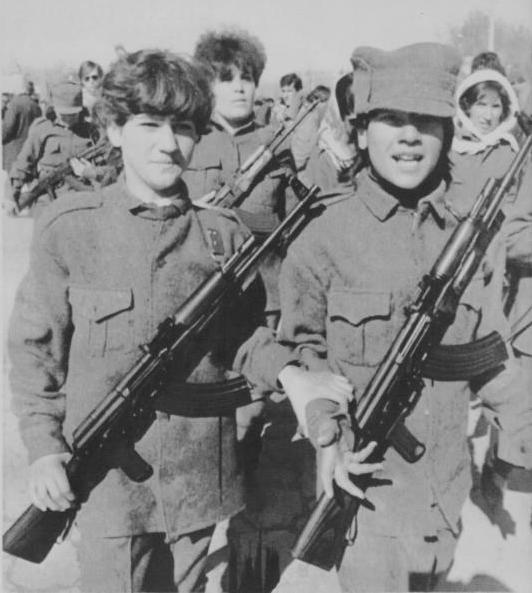
Afghanistan History: Cold War--Mujahideen Resistance to Communist Domination (1978-79)

Figure 1.--There is no caption associated with this press photo, but it looks to us like the Soviet equipped Afghan Army that was being trained to fight the Muhajideen in 1978. Notice that the group here is made up of what looks like city boys and girls. Arming girls was something new to conservative Afghan society. Womeb rights were one of the reforms that that the Afghan resistance especially resented.
|
|
Considerable resistance to the Communist PDPA Governments among tradition-bound Afganis. And this only increased as the PDPA adopted brutal repression to deal with their opponenbts. Taraki and his associates respond as in other Communist countries with mass arrests. Those arrested were tortured to obtain information and to intimidate thosw who were not executed. President Taraki signed a treaty of friendship with the Soviet Union. The Soviets expanded military support. Resistance increased and fighters founded the Mujahideen movement. The name Mujahideen was originally used by the to Afghan fighters who opposed the British Raj's actions into Afghanistan (19th century). The British were reacting to Afghan raids along the Noerthwest Frontier. The name 'Mujahideen' comes from the same Arabic root as jihad, meaning 'struggle'. The Mujahideen
saw themselves as Islamic warriors defending their country from atheistic Communism. They arose from village militias organized by local warloads. They oppsed the Soviet armed Afghani Army which attempted to bring Communism to the countryside. This occurred at the local level with no national coordination. The reflected Afghnistan's ethnic diversity, including Pashtuns, Uzbeks, Tajiks and others. Some were Shi'a with ties to Iran, but most were Sunni Muslims. As Soviet involvement deepened, Muslims from other countries volunteered to join the Mujahideen fighters. A few Arabs (including Osama bin Laden), and fighters from nearr by Chechnya came to join in the fight. The poorly armed Mujahideen had considerable popular support and a substantial opposition formed to the country's repressive and atheist Communist Government. The Soviets initially believed the Mujahideen rebellion could be handled by the Afghan Army that they had trained and armed. The fight did not go well for the PDPA Government. The Soviet backed and equipped Army showed little commitment to fight the Mujahideen. The substantial Army was rapidly reduced by mass desertions. Many soldiers deserted with their weapons. The Afghan Army remained largely ineffective throughout the fight with the Mujahideen. The Government rapidly lost control of large areas of the countryside and appeals for Soviet intervention. At this stage there was little or no American support for the Mujahideen
HBC

Related Chronolgy Pages in the Boys' Historical Web Site
[The 1880s]
[The 1890s]
[The 1900s]
[The 1910s]
[The 1920s]
[The 1930s]
[The 1940s]
[The 1930s]
[The 1940s]
[The 1950s]
[The 1960s]
[The 1970s]
[The 1980s]
Related Style Pages in the Boys' Historical Web Site
[Long pants suits]
[Knicker suits]
[Short pants suits]
[Socks]
[Eton suits]
[Jacket and trousers]
[Blazer]
[School sandals]
[School smocks]
[Sailor suits]
[Pinafores]
[Long stockings]
Navigate the Boys' Historical Clothing Web Page
[Return to the Main Afghan history page]
[Return to the Main Cold War country page]
[Return to the Modern Afghani history]
[Return to the Main Afghan country page]
[Return to the Main Asian history page]
[Return to the Main Middle Eastern human rights page]
[About Us]
[Introduction]
[Biographies]
[Chronology]
[Climatology]
[Clothing]
[Disease and Health]
[Economics]
[Freedom]
[Geography]
[History]
[Human Nature]
[Ideology]
[Law]
[Nationalism]
[Presidents]
[Religion]
[Royalty]
[Science]
[Social Class]
[Bibliographies]
[Contributions]
[FAQs]
[Glossaries]
[Images]
[Links]
[Registration]
[Tools]
[Children in History Home]
Created: 3:12 AM 4/20/2018
Last updated: 3:13 AM 4/20/2018



